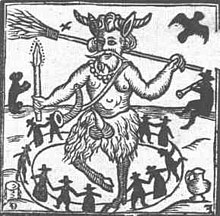Goblin
Goblin is the English name for small, mostly malicious and grotesquely ugly pests or ghosts .
As with the dwarfs and goblins in sagas and fairy tales, the sizes for goblins vary greatly, between a few inches to child size. They also often have magical powers . In the folklore the goblins are sometimes the friendly and helpful, but mischievous hobgoblins or Hobs opposed, which, like the brownies , the brownies are similar. In modern fantasy, the goblins are mostly described as either a technologically highly developed or a very primitive race, which has a great tendency towards cruelty and suicidal behavior paired with a certain madness.
etymology
The origin and meaning of the English word goblin is uncertain; probably a loan word from Old French ( gobelin ). In the Chronicle of the Ordericus Vitalis from the 12th century a gobelinus is mentioned, a spirit that haunted the area of Évreux . Possibly there is a connection with the German word Kobold , or the late Latin cabalus , which in turn goes back to the Greek kobalos ("rogue", "rascal"), or with the personal name Gobel .
reception
In William Shakespeare's ( The Merry Wives of Windsor , A Midsummer Night's Dream ), hobgoblins are fairy-like creatures . However, Oberon's mischievous court jester Puck prefers the name Robin Goodfellow for himself , because the contemporary Puritans in England no longer differentiated between good and bad goblins. For them, all these spirits were diabolical beings depicted in the iconography of ancient Pan or the satyrs .
In the English theatrical comedy The Goblins by John Suckling (1638), on the other hand, the title refers to a band of noble robbers who disguise themselves as devils in order to ensure justice in the manner of Robin Hood and cover the country with their pranks.
John Milton characterizes the goblin in his shepherd poem L'Allegro (1645) as a hardworking house ghost who helps with housework and harvest, but is of tall stature, hairy and strong, similar to a wild man .
In John Bunyan's Puritan edification Pilgrimage to Blessed Eternity (1678), however, hobgoblins, along with satyrs and dragons , are mentioned as residents of the pit of hell .
During the 19th century, goblins and hobgoblins became popular characters in fairy tales and children's books . Christina Rossetti's multi-layered poem Goblin Market (1859) portrays them as insidious, treacherous beings who impose delicious (but forbidden?) Fruits on young girls, the consumption of which leads to mental derangement and death.
George MacDonald described the goblins in his children's book The Princess and the Goblin (1872, German: The Princess and the Goblins ) as hideous and deformed creatures that have lived in caves and mines in the mountains for centuries. They can no longer bear sunlight or singing, hate people and try to subdue them. This representation became an important influence on the design of the orcs in the work of JRR Tolkien and in the later fantasy literature and role-playing games . Initially, Tolkien conceived the hobgoblins as a larger, stronger and more dangerous variety of the little goblins, but as part of his further folklore studies it became clear to him that the original language usage suggests the opposite. So he largely replaced Goblin and Hobgoblin with the names Ork and Uruk-hai.
In fantasy games such as Dungeons & Dragons , World of Warcraft or Warhammer Fantasy , goblins are often depicted as vicious little monsters with green skin and large noses, who are individually weak and like to fall back on insidiousness and inventiveness. As weak monsters, they are often among the first opponents a hero encounters in fantasy games.
In Joanne K. Rowling's Harry Potter novels, goblins (in German translations: " Kobolde ") appear as ugly, short men with long fingers who run the wizard's bank "Gringotts" as unfriendly and curt bankers . They hoard immeasurable treasures in miles of tunnels and dungeons below London .
In Terry Pratchett's Discworld novel Stiff Pinch , the goblins are a species that is suppressed because of their ugliness, smell, and little-known cultural prowess, and counts as part of the animal kingdom. In the course of the plot, this picture turns out to be overly simplistic and distorting. In the end, the goblins are recognized as other species similar to humans and legally equal to them, alongside dwarves, trolls and other typical fantasy figures.
